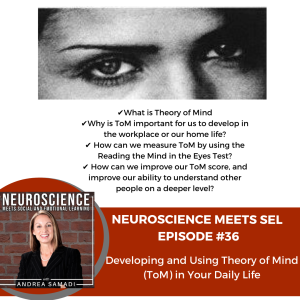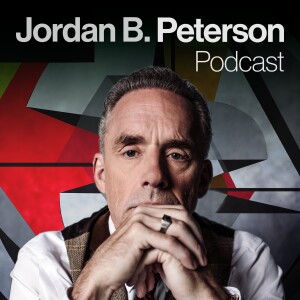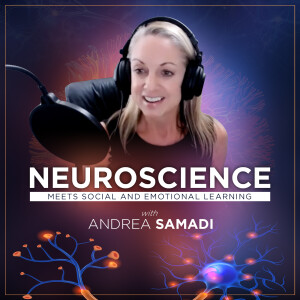
This is episode 46. This week we are on our last solo episode of diving deep into Dr. John Medina’s Brain Rules. I wonder: how are you managing your time during these unexpected life events that are happening in our world today? “You can build up your ‘cognitive reserve,’ or your brain’s innate ability to get a job done, through different types of learning and or through new experiences.” People with a stronger and healthier cognitive reserve—one that’s been strengthened with learned experience—have been shown to be more capable of coping with unexpected life events.” (30 Amazing Facts About Your Brain).[i] I highly encourage using any extra time that you might have in your schedule for learning instead of reading the news or wasting time. This can be a time for all of us to ramp up with our knowledge if we are able to manage the inevitable distraction around us.
Welcome to the Neuroscience Meets Social and Emotional Learning podcast, my name is Andrea Samadi, I’m a former educator whose been fascinated with understanding the science behind high performance strategies in schools, sports and the workplace for the past 20 years. Each week we bring you an expert who has risen to the top of their industry with specific strategies that you can implement immediately, whether you are a teacher or student in the classroom, or working in the corporate world, to take your results to the next level.
In episode 42[ii], Dr. John Medina gave us some new insights on applying 12 Brain Rules to our daily life. I could spend a year on these rules but have just taken a few of the concepts that stuck out to me as important, to dive deep into. Dr. Medina spoke a bit about Theory of Mind as being “as close to mind reading as brain science gets.”[iii] So why is Theory of Mind so important? Theory of Mind (ToM)[iv] is crucial for everyday social interactions with others[v] as it is used to analyze, judge and infer other people’s behaviors. It is an important “social-cognitive skill that involves the ability to think about mental states, both your own and those of others.”[vi]
Psychologists have called this idea a theory because we really do not know exactly what is going on in someone else’s mind, we can only learn to make inferences based on life experience, intuition and practice.
Why would this skill be important in the classroom? Imagine how much easier life would be if you could look at your students and be able to know if they were feeling anxious before a test, or even before a sporting event and be able to intervene with a quick strategy to calm their nerves.
What about in the workplace? Imagine if you were working in a restaurant, how much easier it would be to serve your customers if you could read facial cues that come along with needing something like an empty water glass, or a utensil or maybe even something like warming up a plate of food that came out and wasn’t hot. The ability to look and read what someone else is thinking makes life much easier in these situations and is a skill that can be learned with practice.
Before we take a deeper dive in ToM, I want to tell you when I first learned about this skill. When I was in high school, (In Toronto, Canada where I grew up) there was this awful span of time where there were crimes committed by someone the media called the Scarborough rapist (late 1980s-1990s). Anyone living in Canada at this time would remember when they finally caught this man, who committed these terrible crimes with his wife that ended up being the most horrific crimes in Canadian history, the media changed what they called them to the Ken and Barbie Killers based on their appearance. I remember asking my Mom at the time, “how would I ever know if someone is bad, if these two people could be so evil, yet they don’t look evil at a glance?”
My Mom looked at me and said, “you can’t see it in their eyes?” and sat me down at the kitchen table and started what were known as our “reading the mind in the eyes” lessons which I now know can be tested. You can test your social intelligence score and how well you can read the emotions of others by looking in their eyes with the Theory of Mind Test[vii] that was developed by Professor Simon Baron Cohen at the University of Cambridge (yes, this is the cousin of the well-known Sasha Baron Cohen—the English actor and comedian).
I don’t know what training my Mom had with Theory of Mind, but we started these lessons by taking random people’s photographs from the local newspapers, and she would teach me to isolate one eye with a piece of paper. Then she would ask me to tell her what feelings I would get from looking at that one eye. At first it was really difficult, and I wasn’t sure what feelings I was getting, and of course, who wants to just guess and get this all wrong. After a few weeks of reading regular people’s eyes, she asked me to isolate the eyes of that evil couple from a photo that appeared in the paper. At first glance, the photo looked like just anyone else on their wedding day but when I isolated their eyes, I saw what she meant. I could read more into these two people from this practice of looking into their eyes than I could just at a quick glance of their entire face.
This began my practice of learning ToM that was a skill that became very useful later in life. I just wish I had always listened to what I would feel from people’s eyes, because this skill can help you navigate life with ease, if you can learn to develop and then listen to what you feel.
Tips for Reading the Mind Through the Eyes
- Where to begin? Start with photographs and isolate one eye, and just listen to what you feel. Start with photographs of world leaders, or people whose character you know already to begin.
- What are you looking for? Study real people when you are interacting with them and look at both of their eyes. Pay attention to what you feel. Emotions like happiness, fear or sadness show up in someone’s eyes, just as when someone is not telling you the truth. You should be able to recognize when your child is telling you they have a stomachache if they really don’t feel well, or if it’s something else that is bothering them by looking at their eyes.
- Verify what you think. Write down what you learn and if you know the person you are studying well enough, ask them what they think.
- Learn and improve. How can what you are learning help you to be a better friend, spouse, employee, parent, or coworker?
Dr. Medina talked about ToM in episode 42 with the question I asked him about Art Linkletter and Walt Disney. He defined ToM as “the ability to understand the intentions and motivations of someone else” and because Walt Disney didn’t have this ability, when he was describing his vision of Disneyland to his friend, years before it became a reality, he missed some important social cues with Art Linkletter that could have allowed for a completely different outcome if the two had partnered together with this venture.
Dr. Medina did say that there is scientific evidence on how to improve ToM that’s been well documented in research. He says that you can improve your ToM score by reading narrative fiction, 10-15 minutes a day, by authors who have won awards (so that you are reading well thought out sentences). He suggests to create book clubs and study literature as a group to continue to work on this skill.
If you are curious about your ToM score, you can take the test yourself[viii] and then see if you can use these tips to improve your score, and with time and practice, improve your social interactions as you become more in tune with others. I scored 29/36 with this test and know there is always room for improvement with anything we are learning. If you take the test, I would love to know how you score.
To close this episode, I just want to remind you to go back and listen to Dr. John Medina’s episode #42[ix] if you want to hear his thoughts on ToM. Also, episode 22[x] is a powerful lesson to review with Yale Center for Emotional Intelligence, Marc Brackett on his book “Permission to Feel” as a reminder for how to recognize our own emotions and the importance of self-regulation, especially during the difficult times we are facing in our world today. If we can all do our part to work on ourselves, just a little bit each day, like Aristotle said, “the whole is greater than the sum of its parts.” We can achieve more together.
REFERENCES:
[i]72 Amazing Human Brain Facts by Deane Alban November 1, 2019 https://bebrainfit.com/human-brain-facts/
[ii] Neuroscience Meets Social and Emotional Learning Podcast EPISODE 42 Dr. John Medina on “Implementing Brain Rules in Schools and Workplaces of the Future” https://podcasts.apple.com/us/podcast/dr-john-medina-on-implementing-brain-rules-in-schools/id1469683141?i=1000466618504
[iii] As Close to Mind Reading as Brain Science Gets YouTube Published July 11, 2017 https://www.youtube.com/watch?v=ELOXxwyRN74
[iv] Theory of Mind: Mechanisms, Methods and New Directions Published August 13, 2008 https://www.ncbi.nlm.nih.gov/pmc/articles/PMC3737477/
[v] Why is Theory of Mind Important for Referential Communication? Published August 10, 2016 (Sidera, Perpina, Serrano, Rostan) https://www.ncbi.nlm.nih.gov/pmc/articles/PMC6132837/
[vi] How the Theory of Mind Helps Us to Understand Others by Kendra Cherry Oct. 1, 2019 https://www.verywellmind.com/theory-of-mind-4176826
[vii] Theory of Mind Test NOTE: My score was 29/36 http://socialintelligence.labinthewild.org/mite/
[viii] Theory of Mind Test NOTE: My score was 29/36 http://socialintelligence.labinthewild.org/mite/
[ix] Neuroscience Meets Social and Emotional Learning Podcast EPISODE 42 Dr. John Medina on “Implementing Brain Rules in Schools and Workplaces of the Future” https://podcasts.apple.com/us/podcast/dr-john-medina-on-implementing-brain-rules-in-schools/id1469683141?i=1000466618504
[x] Neuroscience Meets Social and Emotional Learning Podcast EPISODE 22 Marc Brackett on his book “Permission to Feel” https://podcasts.apple.com/us/podcast/yale-center-for-emotional-intelligence-founder-marc/id1469683141?i=1000450933434
More Episodes
Insights from Grant 'Upbeat' Bosnick: "The Hydrated Brain for Improving Our Cognitive Performance" Chapter 6 on Physical Health
 2024-03-10
2024-03-10
 734
734
Insights from Grant 'Upbeat' Bosnick: The Neuroscience of Peak Performance and Happiness (Flow) Chapter 5
 2024-03-03
2024-03-03
 803
803
Insights from Grant 'Upbeat' Bosnick's Tailored Approaches to Self-Leadership: The Neuroscience of Mindfulness (Chapter 4)
 2024-02-21
2024-02-21
 867
867
Insights from Grant 'Upbeat' Bosnick's Tailored Approaches to Self-Leadership: The Neuroscience of Inspiration (Chapter 3)
 2024-02-12
2024-02-12
 834
834
Insights from Grant 'Upbeat' Bosnick's Tailored Approaches to Self-Leadership: Using Neuroscience to Level Up Your Goals (Chapter 2)
 2024-02-10
2024-02-10
 754
754
The Silva Method: Transforming Minds and Paving the Future with the Most Downloaded Series from 2023
 2024-02-04
2024-02-04
 1.5k
1.5k
Grant 'Upbeat' Bosnick on "Tailored Approaches to Self-Leadership: A Bite Size Approach Using Psychology and Neuroscience"
 2024-01-28
2024-01-28
 916
916
PART 7 Review of Wallace D. Wattles The Science of Getting Rich on " Acting in A Certain Way" Chapters 11-17
 2024-01-20
2024-01-20
 1.2k
1.2k
PART 6 Review of Wallace D. Wattles The Science of Getting Rich on ”How to Think in This Certain Way” Chapters 6, 8, 9, 10.
 2024-01-13
2024-01-13
 960
960
PART 5 Review of Wallace D. Wattles The Science of Getting Rich on ” Revealing The Secret Within the Syllabus” Chapters 1, 2, 3 and 5
 2024-01-03
2024-01-03
 1.1k
1.1k
Dmitri Leonov on ”Taopatch: Understanding Nanotechnology for Health and Wellness of The Future”
 2023-12-31
2023-12-31
 943
943
PART 4 Review of The Science of Getting Rich on ”Gratitude: Through the Eyes of Wallace D. Wattles” Chapter 7
 2023-12-20
2023-12-20
 940
940
PART 3: Review of Wallace D. Wattles The Science of Getting Rich on ”The Neuroscience Behind The Impression of Increase” Chapter 14
 2023-12-16
2023-12-16
 954
954
PART 2: Review of Wallace D. Wattles The Science of Getting Rich on ”Thinking and Acting in a Certain Way” Chapter 4
 2023-12-10
2023-12-10
 1.1k
1.1k
PART 1 Review of Wallace D. Wattles The Science of Getting Rich on ”Prosperity Consciousness” Introduction
 2023-12-02
2023-12-02
 1.4k
1.4k
”Decoding Our Thoughts: How to Build a Better Future with the Power of Our Mind” PART 4 Review of Dr. Joe Dispenza’s Work
 2023-11-19
2023-11-19
 1.2k
1.2k
The Frequency Expert, David Wong on ”Master Your Frequency and Take Control of Your Personal, Professional Life and Health”.
 2023-11-11
2023-11-11
 1.3k
1.3k
”Decoding Our Thoughts: How to Build a Better Future with the Power of Our Mind” PART 3 Review of Dr. Joe Dispenza’s Work
 2023-11-05
2023-11-05
 1.1k
1.1k
”Decoding Our Thoughts: How to Build a Better Future with the Power of Our Mind” PART 2 Review of Dr. Joe Dispenza’s Work
 2023-10-26
2023-10-26
 1.4k
1.4k
Dianne Kosto ”From Trauma to Triumph: A Mom’s Mission With Neurofeedback”
 2023-10-19
2023-10-19
 1.3k
1.3k
Get your brand heard on this podcast
Join Podbean Ads Marketplace and connect with engaged listeners.
Advertise Today
Create your
podcast in
minutes
- Full-featured podcast site
- Unlimited storage and bandwidth
- Comprehensive podcast stats
- Distribute to Apple Podcasts, Spotify, and more
- Make money with your podcast
It is Free
You may also like

Mayo Clinic Talks


The Saad Truth with Dr. Saad


Positive Thinking Mind


ŒIL pour YEUX, DENT pour MÂCHOIRE 😎


The Jordan B. Peterson Podcast


- Privacy Policy
- Cookie Policy
- Terms of Use
- Consent Preferences
- Copyright © 2015-2024 Podbean.com



 iOS
iOS Android
Android